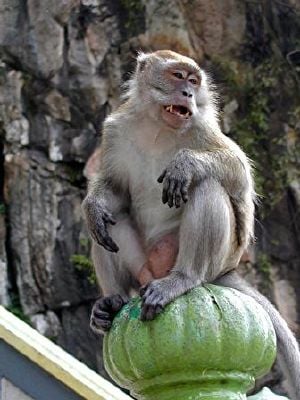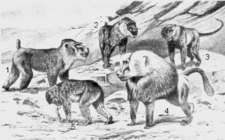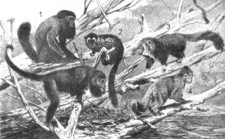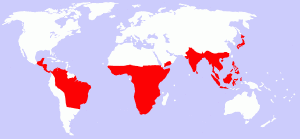Monkey

A monkey is any member of two of the three groupings of simian primates, the New World monkeys and the Old World monkeys. The New World monkeys are found in Mexico, Central America, and South America, and the Old World monkeys are located in Africa, central to southern Asia, Japan, and India. There are more than 250 extant species between the two groups.
The biological order primates is divided informally into three main groupings: prosimians, monkeys of the New World, and monkeys and apes of the Old World. Together, the New World monkeys and the Old World monkeys and apes are considered to be "higher primates," or simians (infraorder Similformes), while the prosimians (such as lemurs) are considered to be the "lower primates." The term monkey thus refers to any simian that is not an ape. The term may also be defined as any primate that is not an ape (including humans) or a prosimian. In reality, monkeys are not a single coherent group and therefore do not have any particular traits that they all share.
Humans and monkeys are so similar that researchers even study behaviors of monkeys, such as a sense of "fairness," to try and better understand the origin of human behaviors (see below). However, despite the genetic and anatomical similarities, humans remain radically unique from other primates in many aspects, including having complex technologies, complex spoken and written languages, highly developed cultural institutions, unique moral and religious beliefs, and so forth.
Apes, such as chimpanzees and gibbons, are sometimes incorrectly called monkeys because of their similarity to monkeys. Also, a few monkey species have the word ape in their common name, but are not true apes.
Characteristics
Monkeys range from the size of a mouse to that of a medium-sized dog. The pygmy marmoset, for instance, is only about five inches (14 centimeters) long, including its tail, and weighs four to five ounces (120 to 140 grams). The male mandrill, on the other hand, measures almost three feet (one meter) in length and weighs 75 pounds (35 kilograms). Some monkeys are arboreal (living in trees), while others, like macaques and baboons, spend more time on the ground.
Diets, which differ among the various species, may include: fruit, leaves, seeds, nuts, flowers, insects, spiders, eggs, and small animals such as bats. All monkeys use their hands and feet for holding onto branches.
The species within each group share some general characteristics.
- Tails: most New World monkeys have prehensile tails (adapted for grasping or holding), while Old World monkeys do not.
- Noses: most New World monkeys are flat nosed and have round nostrils set far apart; Old World monkeys have downfacing noses and their nostrils are curved and set closer together.
- Teeth: New World monkeys have three premolars; Old World monkeys have two premolars.
- Rump pads, also called sitting pads: some Old World monkeys are supported by these thickly calloused areas of skin while they sit
- Cheek pouches: Some Old World monkeys, such as macaques, have cheek pouches to store food so it can be eaten later; New World monkeys do not have these structures.
- Hands: New World Monkeys' thumbs are in line with the other digits, and some species have toenails on the big toe; the thumbs of Old World monkeys are rotated and more opposable, like humans, and all have fingernails and toenails on every digit.
According to Trivedi (2003), New World monkeys have a broad range of vision types. Howler monkeys have trichromatic, or three-color vision, having light sensitive cells in the retina that can distinguish blue, green, and red colors. The owl monkey sees only in black and white (monochromatic). In spider monkeys and tamarins, the males have dichromatic vision, not being able to perceive reds or greens, while about 60 percent of the females have three-color vision. Old World species tend to have three-color vision, such as with humans.
Name
According to the Oxford English Dictionary, the name monkey may come from a German version of the Reynard the Fox fable, published in the late sixteenth century. In this version, a character named Moneke is the son of Martin the Ape. The word Moneke may have been derived from the Italian monna, which means "a female ape." The name Moneke persisted over time likely due to the popularity of Reynard the Fox.
A group of monkeys is called a mission or a tribe.
Classification

The following list shows where the various monkey families are placed in the primate classification. Note that the smallest grouping that contains them all is the simiiformes—the simians—which also contains the apes.
Technically, the distinction of catarrhines (Old World monkeys) from platyrrhines (New World monkeys) depends on the structure of the nose, and the distinction of Old World monkeys from apes depends on dentition (the development of teeth and their arrangement in the mouth). (Numbers of species are approximate, since new species are occasionally found or subspecies are redefined as species or vice versa.)
- ORDER PRIMATES
- Suborder Strepsirrhini: non-tarsier prosimians
- Suborder Haplorrhini:’’’ tarsiers, monkeys, and apes
- Infraorder Tarsiiformes
- Family Tarsiidae: tarsiers (7 species)
- Infraorder Simiiformes: simians
- Parvorder Platyrrhini:’’’ New World monkeys
- Family Cebidae: marmosets, tamarins, capuchins and squirrel monkeys (56 species)
- Family Aotidae: night or owl monkeys (douroucoulis) (8 species)
- Family Pitheciidae: titis, sakis, and uakaris (41 species)
- Family Atelidae: howler, spider, and woolly monkeys (24 species)
- Parvorder Catarrhini
- Superfamily Cercopithecoidea
- Family Cercopithecidae:’’’ Old World monkeys (135 species)
- Subfamily Cercopithecinae
- Subfamily Colobinae
- African group (colobus)
- Langur (leaf monkey) group (langurs, leaf monkeys, surilis)
- Odd-Nosed group (doucs, snub-nosed monkeys, Proboscis monkey, Pig-tailed Langur)
- Family Cercopithecidae:’’’ Old World monkeys (135 species)
- Superfamily Hominoidea: Apes (simians, but not monkeys)
- Family Hylobatidae: gibbons or "lesser apes" (13 species)
- Family Hominidae: humans and other "great apes" (gorillas, orangutans, and chimpanzees) (7 species)
- Superfamily Cercopithecoidea
- Parvorder Platyrrhini:’’’ New World monkeys
- Infraorder Tarsiiformes
Old World monkeys
| Old World monkeys | ||||||||||||||
|---|---|---|---|---|---|---|---|---|---|---|---|---|---|---|
 | ||||||||||||||
| Scientific classification | ||||||||||||||
| ||||||||||||||
| Subfamilies | ||||||||||||||
|
Cercopithecinae – 11 to 12 genera |
The Old World monkeys or Cercopithecidae are a group of primates, falling in two subfamilies in the clade Catarrhini (Groves 2001). Those monkeys in the subfamily Cercopithecinae are mainly African but include the diverse genus of macaques that live in Asia and North Africa. The subfamily Colobinae make up most of the Asian genera, but also include the African colobus monkeys.
From the point of view of superficial appearance, Old World monkeys are unlike apes in that most have tails (the family name means "tailed ape"), and unlike the New World monkeys in that their tails are never prehensile.
Several Old World monkeys have anatomical oddities. Colobus monkeys have a stub for a thumb. The proboscis monkey has an extraordinary nose while snub-nosed monkeys have almost no nose at all. Male mandrills have a red penis and lilac-colored scrotum, and their faces also have bright coloration. Alpha males, the dominant male in a group with several males, have the brightest coloration.
The Old World monkeys are native to Africa and Asia today, but are also known from Europe in the fossil record. They include many of the most familiar species of non-human primates.
Classification of Old World monkeys
- Superfamily Cercopithecoidea
- Family Cercopithecidae:’’’ Old World monkeys
- Subfamily Cercopithecinae
- Tribe Cercopithecini
- Genus Allenopithecus (Allen's swamp monkey)
- Genus Miopithecus (Talapoins)
- Genus Erythrocebus (Patas monkey)
- Genus Chlorocebus (green monkey and others)
- Genus Cercopithecus (blue monkey, golden monkey, guenons, etc.)
- Tribe Papionini
- Tribe Cercopithecini
- Subfamily Colobinae
- African group
- Genus Colobus (colobus)
- Genus Piliocolobus (colobus)
- Genus Procolobus (colobus)
- Langur (leaf monkey) group (langurs)
- Genus Semnopithecus (langurs)
- Genus Trachypithecus (langurs, lutungs, leaf monkeys)
- Genus Presbytis (surilis, langurs, leaf monkeys)
- Odd-Nosed group
- Genus Pygathrix (doucs)
- Genus Rhinopithecus (snub-nosed monkeys)
- Genus Nasalis (proboscis monkey)
- Genus Simias (pig-tailed langur)
- African group
- Subfamily Cercopithecinae
- Family Cercopithecidae:’’’ Old World monkeys
New World monkeys
| New World monkeys | ||||||||||||||
|---|---|---|---|---|---|---|---|---|---|---|---|---|---|---|
 | ||||||||||||||
| Scientific classification | ||||||||||||||
| ||||||||||||||
| Families | ||||||||||||||
|
Cebidae |
The New World monkeys are the four families of primates, the Cebidae, Aotidae, Pitheciidae, and Atelidae, that are found in Central and South America (Groves 2001). The four families are ranked together as the Platyrrhini clade.
All New World monkeys differ slightly from Old World monkeys in many aspects, but the most prominent of which is the nose. This is the feature used most commonly to distinguish between the two groups. The scientific name for New World monkey, Platyrrhini, means "flat nosed," therefore the noses are flatter, with side facing nostrils, compared to the narrow noses of the Old World monkey.
Most New World monkeys have long, often prehensile tails. Many are small, arboreal (live in trees), and nocturnal (active at night), so scientists' knowledge of them is less comprehensive than that of the more easily observed Old World monkeys. Unlike most Old World monkeys, many New World monkeys form monogamous pairs, and show substantial paternal care of young.
The Cebidae family includes marmosets, tamarins, capuchins, and squirrel monkeys. The Aotidae family includes night or owl monkeys. The Pitheciidae family includes titis, sakis, and usakaris. The Atelidae family includes the howler, spider, and woolly monkeys.
Monkeys in captivity and research
When the British first began to explore Africa, young monkeys were often captured to provide entertainment during long voyages. Some were later transferred to domestic zoos, and in fact many modern captive monkeys in the United Kingdom are descended from individuals captured during the Napoleonic and Victorian eras.
Some monkeys are kept as pets today. There is some opposition to this practice on moral grounds. In addition, the animals have been known to become aggressive as they age, even toward their owners. Monkeys raised as pets are often given to zoos and sanctuaries when they get older, though some people report having long and rewarding relationships with monkeys.
In most large metropolitan areas in the United States, it is illegal to keep monkeys in private homes. Even in places where they are legal, a permit from the U.S. Department of Agriculture is usually required. Their legal status as pets varies in other countries.
Macaques, especially rhesus monkeys, and African green monkeys are widely used in animal testing facilities. This is primarily because of their relative ease of handling, their fast reproductive cycle (compared to apes), and their psychological and physical similarity to humans. In the United States, around 50,000 non-human primates, most of them monkeys, were used in experiments every year between 1973 and 2003 (APHIS 2004); 10,000 monkeys were used in the European Union in 2004. Use of monkeys in laboratories is highly controversial. Many claim that the practice is cruel and produces little information of value, and there have been many protests and instances of vandalism against it. However, defenders of testing on monkeys say that the research has led to many important medical breakthroughs, and that the prevention of harm to humans should be a higher priority than the harm done to monkeys. The topic has become a popular cause for animal rights groups.
Monkeys and humans are so similar in anatomy and genetics that they are popularly studied to try and understand more about human physiology, health, and even behavior. For example, researchers have compared a sense of "fairness" found in capuchin monkeys (Cebus apella) with humans. In reality, however, despite the anatomy and genetic similarities, the divergence between monkeys and humans is immense, whether one is discussing cultural aspects (political and educational systems, religious traditions, scientific discoveries), language (use of symbols in language, written and spoken languages), or sense of self-awareness and complex technologies.
ReferencesISBN links support NWE through referral fees
- Animal and Plant Health Inspection Service (APHIS). 2004. Animal Welfare Act 2004: Inspections. Retrieved July 12, 2007.
- Fleagle, J. G. 1987. Primate Adaptation and Evolution. Albany, NY: State University of New York Press. ISBN 0887065872
- Groves, C. P. 2001. Primate Taxonomy. New York: HarperCollins. ISBN 156098872X
- Groves, C., D. E. Wilson, and D. M. Reeder, eds. 2005. Mammal Species of the World, 3rd ed. Baltimore: Johns Hopkins University Press. ISBN 0-801-88221-4
- Trivedi, B. P. 2003. Monkeys and Humans See Differently, Experts Say. National Geographic News (Online), November 26, 2003. Retrieved July 12, 2007.
Credits
New World Encyclopedia writers and editors rewrote and completed the Wikipedia article in accordance with New World Encyclopedia standards. This article abides by terms of the Creative Commons CC-by-sa 3.0 License (CC-by-sa), which may be used and disseminated with proper attribution. Credit is due under the terms of this license that can reference both the New World Encyclopedia contributors and the selfless volunteer contributors of the Wikimedia Foundation. To cite this article click here for a list of acceptable citing formats.The history of earlier contributions by wikipedians is accessible to researchers here:
The history of this article since it was imported to New World Encyclopedia:
Note: Some restrictions may apply to use of individual images which are separately licensed.

